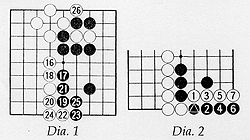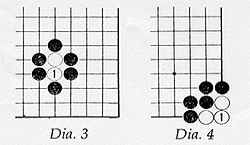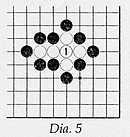Defending territory
 After you have mapped out territory, it is often necessary to make a reinforcing move to defend it. For example, Black 25 in Diagram 1 (Figure 4 in the column two weeks ago) is an important defensive move.
After you have mapped out territory, it is often necessary to make a reinforcing move to defend it. For example, Black 25 in Diagram 1 (Figure 4 in the column two weeks ago) is an important defensive move. If Black omits this move, White will play 1 in Diagram 2, threatening to capture the marked black stone. Black cannot escape. If he tries to run away with 2 and 4, White pursues him with 3 and 5, driving the black stones into the corner, where they run out of liberties. White captures four stones with 7. Not only does this capture gain White eight points, but it also wipes out most of Black's territory on the right.

Illegal moves
In general, you can play on any vacant intersection, but there are some restrictions. One is that you cannot commit suicide. In other words, you cannot play so as to fill the last liberty of your own stones. Here are some examples. White cannot play 1 in Diagram 3. If he were to do so, his two stones would be without liberties, so they couldn't remain on the board. Similary, White cannot play at 1 in Diagram 4 and Diagram 5, as his stones there would also lack liberties. This prohibition on suicide is an important concept in understanding whether groups live or die. This will be the subject of our next column.
White cannot play 1 in Diagram 3. If he were to do so, his two stones would be without liberties, so they couldn't remain on the board. Similary, White cannot play at 1 in Diagram 4 and Diagram 5, as his stones there would also lack liberties. This prohibition on suicide is an important concept in understanding whether groups live or die. This will be the subject of our next column.
